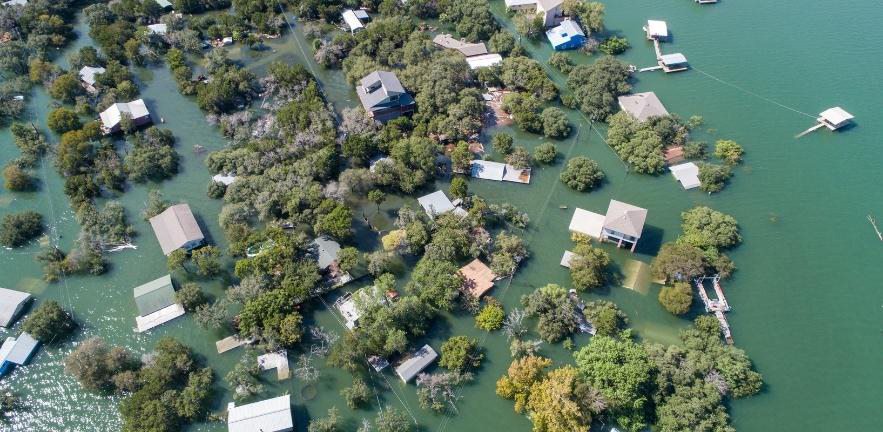Climate change, not just hot and dry but also cold and wet weather, negatively impacts 10 economic sectors in 48 US states, finds a new 53-year study led at the University of Cambridge.
Most climate-change studies have focused on the effect of global warming at country level, particularly on crop yields, but such research has drawbacks because it fails to reflect geographic diversity within a huge country like the US.
A new study led at the University of Cambridge and supported by the Keynes Fund breaks new ground by looking at environmental impact over five decades on 10 different economic sectors (including mining, transport and retail) in the 48 contiguous US states (excluding Alaska and Hawaii) over 53 years (1963-2016) – and concludes that cold and wet weather compared to historical norms (what we have adapted to or get used to over time) have greater negative macroeconomic effects than hot and dry weather in certain sectors.
Geographic granularity of data allows state-by-state comparison

“The geographic granularity of data in the US, and differences in climate from state to state, allowed us to test whether certain sectors of the economy or different states were more or less affected by climate change,” said study co-author Kamiar Mohaddes, Associate Professor in Economics & Policy at Cambridge Judge Business School and a Fellow at King’s College, Cambridge.
The new state-by-state findings are spelled out in a study – entitled Climate Change and Economic Activity: Evidence from US States – posted in the Cambridge Working Papers in Economics series.
“Most discussions of climate change focus on the expected increase in average global temperatures over the next century,” the paper says. “However, the frequency and severity of weather events (such as heat or cold waves, droughts and floods, as well as natural disasters) depend heavily on the variability of temperatures and precipitation as well as their mean. The larger the swings, the more often extremely hot or cold and wet or dry conditions can wreak havoc.”
“Climate change has a long-lasting adverse impact on real output” in various states and sectors, affecting labour productivity and employment in the US, says the research.
Asymmetrical effect of temperature and precipitation
Previous studies have typically looked at the effect on crop yields of extreme temperature or drought, and the results have largely been similar across different countries. The new research finds, however, that the macroeconomic effect of extreme temperature and precipitation is “asymmetrical” with regard to different types of weather – with cold and wet weather having a bigger impact in certain industries.
“The within-country geographic heterogeneity of the US enables one to compare whether economic activity in ‘hot’ or ‘wet’ states responds to a temperature increase in the same way as economic activity does in ‘cold’ or ‘dry’ states,” the study says. “The richness of the United States data also allows for a more disaggregated study of the climate change-growth relationship and enables one to test whether the country at the aggregate level, parts of the country, or particular sectors of the economy have been affected more by climate change.”
The study is based on a novel econometric strategy that links deviations of temperature and precipitation from their long-term historical norms to state-specific economic performance indicators over the period 1963 to 2016 – including Gross State Product (GSP), GSP per capita, labour productivity and employment, as well as output by sector.
The paper finds that over the 53-year study period, on average, the 48 contiguous US states had a rise in temperature of 0.0260 degrees Celsius per year, which was higher than the world average increase of 0.018 degrees Celsius per annum over the same period. Within those 48 states, Oklahoma had the lowest temperature rise, at 0.171 degrees Celsius per year, while Delaware had the highest temperature rise of 0.0355 degrees Celsius per year.
Four climate variables examined
“We found that each of the 10 economic sectors we looked at is affected by at least one of the four climate variables we focused on – deviations of temperature above and below its historical norm, as well as the deviations of precipitation above and below its norm,” says Professor Kamiar Mohaddes. “The sectors most affected overall included construction, mining, retail trade and services, while less-affected sectors included finance and insurance as well as government.”
The 10 sectors studied were agriculture, forestry and fisheries; mining; construction; manufacturing; transport, communications and public utilities; wholesale trade; retail trade; financial services and property; services; and government.
The study’s estimates show that output growth in mining, construction, transport, retail trade, wholesale trade, services and government sectors are all negatively affected by unusually cold days in the US – which the study traces to falling consumer spending (delayed shopping or spending that is reduced due to higher heating or home-repair costs). As for unusually wet weather, this can reduce access to mountainous mining regions, while construction and transport activities are affected by rain and snow.
“While we show that there has been some welcome adaptation by US states to climate change, the evidence suggests that adaptation efforts should be complemented with mitigation policies to minimise the adverse effects of climate change,” says Kamiar. “Investment in green-related innovation is key as is policies that encourage climate mitigation related to buildings, energy, transportation, and production in general as we transition to a green economy.”
Kamiar has co-authored several other recent studies that showcased the economic effect of climate change, including a study that showed the effect of climate change on countries’ credit ratings; a KPMG report which concluded that green investments can improve the environment and the economy at the same time; and research that linked climate change to national GDP. The study linking climate change to national GDP was cited last year by the US Congressional Budget Office and in a letter by 25 members of Congress to US Federal Reserve Board Chairman Jerome Powell.
“Overall, the industry-level results…show that deviations of temperature below its historical norms in the US as well as deviations of precipitation from its historical norm are detrimental to long-term state-level and industry-level output growth,” the study concludes.
The paper – Climate Change and Economic Activity: Evidence from US States – is co-authored by Professor Kamiar Mohaddes of Cambridge Judge Business School; Ryan N.C. Ng of the Faculty of Economics, University of Cambridge; M. Hashem Pesaran of the University of Southern California and Trinity College, University of Cambridge; Mehdi Raissi of the International Monetary Fund in Washington; and Jui-Chung Yang of National Taiwan University.


